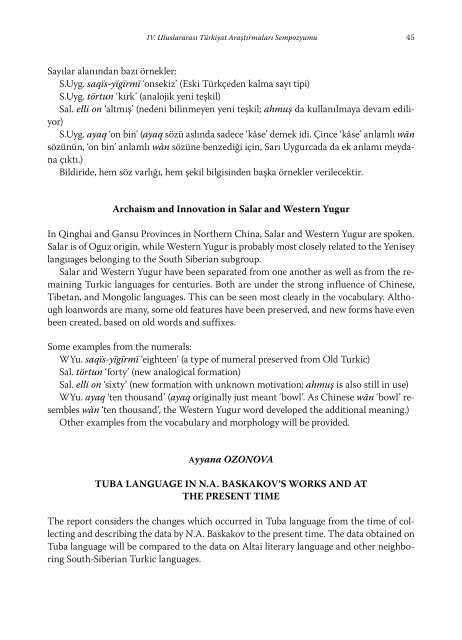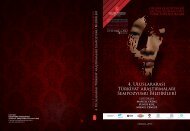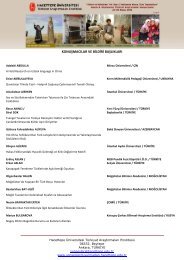bildiri özetleri - Dilleri ve Kültürleri Yok Olma Tehlikesine Maruz Türk ...
bildiri özetleri - Dilleri ve Kültürleri Yok Olma Tehlikesine Maruz Türk ...
bildiri özetleri - Dilleri ve Kültürleri Yok Olma Tehlikesine Maruz Türk ...
Create successful ePaper yourself
Turn your PDF publications into a flip-book with our unique Google optimized e-Paper software.
IV. Uluslararası Türkiyat Araştırmaları Sempozyumu 45<br />
Sayılar alanından bazı örnekler:<br />
S.Uyg. saqïs-yïgïrmï ‘onsekiz’ (Eski Türkçeden kalma sayı tipi)<br />
S.Uyg. törtun ‘kırk’ (analojik yeni teşkil)<br />
Sal. elli on ‘altmış’ (nedeni bilinmeyen yeni teşkil; ahmuş da kullanılmaya devam ediliyor)<br />
S.Uyg. ayaq ‘on bin’ (ayaq sözü aslında sadece ‘kâse’ demek idi. Çince ‘kâse’ anlamlı wăn<br />
sözünün, ‘on bin’ anlamlı wàn sözüne benzediği için, Sarı Uygurcada da ek anlamı meydana<br />
çıktı.)<br />
Bildiride, hem söz varlığı, hem şekil bilgisinden başka örnekler <strong>ve</strong>rilecektir.<br />
Archaism and Innovation in Salar and Western Yugur<br />
In Qinghai and Gansu Provinces in Northern China, Salar and Western Yugur are spoken.<br />
Salar is of Oguz origin, while Western Yugur is probably most closely related to the Yenisey<br />
languages belonging to the South Siberian subgroup.<br />
Salar and Western Yugur ha<strong>ve</strong> been separated from one another as well as from the remaining<br />
Turkic languages for centuries. Both are under the strong influence of Chinese,<br />
Tibetan, and Mongolic languages. This can be seen most clearly in the vocabulary. Although<br />
loanwords are many, some old features ha<strong>ve</strong> been preser<strong>ve</strong>d, and new forms ha<strong>ve</strong> e<strong>ve</strong>n<br />
been created, based on old words and suffixes.<br />
Some examples from the numerals:<br />
WYu. saqïs-yïgïrmï ‘eighteen’ (a type of numeral preser<strong>ve</strong>d from Old Turkic)<br />
Sal. törtun ‘forty’ (new analogical formation)<br />
Sal. elli on ‘sixty’ (new formation with unknown motivation; ahmuş is also still in use)<br />
WYu. ayaq ‘ten thousand’ (ayaq originally just meant ‘bowl’. As Chinese wăn ‘bowl’ resembles<br />
wàn ‘ten thousand’, the Western Yugur word de<strong>ve</strong>loped the additional meaning.)<br />
Other examples from the vocabulary and morphology will be provided.<br />
Ayyana OZONOVA<br />
TUBA LANGUAGE IN N.A. BASKAKOV’S WORKS AND AT<br />
THE PRESENT TIME<br />
The report considers the changes which occurred in Tuba language from the time of collecting<br />
and describing the data by N.A. Baskakov to the present time. The data obtained on<br />
Tuba language will be compared to the data on Altai literary language and other neighboring<br />
South-Siberian Turkic languages.





